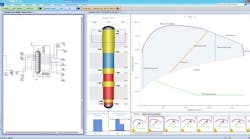Demand is rising for applying advanced process control (APC) in more controllers and on more units. “APC is not just for big units, it’s being used on secondary systems like utility and steam systems,” says Elinor Price, senior director, product marketing, Manufacturing and Supply Chain at Aspen Technology (AspenTech).
But APC has traditionally been the province of dedicated specialists with years of training and experience. “Building, deploying and maintaining a system used to require on-site expertise, using multiple sets of tools for each controller,” says Price. Those separate build, deploy and maintain modules have been right-click-heavy, not workflow-oriented. Individual programming styles are evident in the resulting implementations, which can make them hard for other engineers to troubleshoot and maintain.
Also, today’s new engineers expect modern, intuitive -user interfaces. “Our active user community wanted to streamline the workflow, and we wanted to take into account changing demographics but keep the solution just as efficient for experienced users,” Price says. “Plants need APC applications that are easier to deploy and support, and management wants to capture the knowledge of experts—to capture their workflows and best practices.”
So AspenTech is introducing Aspen DMC3 Builder, an integrated platform with a modernized interface for building and deploying all the company’s APC controllers from start to finish. Its intuitive user interface has a mainstream ribbon-based layout, designed to correspond to the APC project workflow. Features are exposed in the right context and at appropriate times, improving project efficiency. “Menu bar options are active or inactive, depending on where you are in the workflow,” explains Price. The result is higher efficiency for both power users and less experienced engineers.
Dozens of APC Resources within DMC3 Builder allow users to access information about APC products, share process and industry knowledge and tips with other users, and search for knowledge base articles, training videos, tutorials and more.
“aspenONE Exchange is a portal across engineering and manufacturing solutions where users can see how to do things with a ‘just show me,’ YouTube approach,” adds Dinu Ajikutira, senior director, product marketing, Engineering at Aspen Technology (AspenTech). For example, if you need a particular feed model or dynamic model, or to troubleshoot a column or solve a problem, you can find an example. “It’s a dynamic environment. We have a lot of acceptance in the community with 5,000 unique users per month,” he says.
AspenTech is also introducing Column Analysis to Aspen HYSYS and Aspen Plus. Column Analysis is an interactive tool with enhanced calculations and visualizations for the hydraulic behavior of trayed and packed columns. “Prior to V9, the only tools for modeling column hydraulics were TPSAR in Aspen Plus and the tray sizing utility in Aspen HYSYS,” says Ajikutira.
Column Analysis presents a visual environment for more rigorous analysis of operating point and ranges. This innovative tool can be used to evaluate the effects of process changes on hydraulic performance of the column.
“Users can see what’s going on inside the column,” Ajikutira says. ”New and experienced engineers can troubleshoot operational issues and evaluate options for designing new columns and revamping existing columns.” They can determine the root cause of operational issues without expensive physical inspection of the column, and understand the behavior of columns to address or avoid operational mishaps with visual presentations of inputs and results, as well as clear messages to explain problems and potential solutions.
“They can see the column as part of the larger process with an interactive solver for quick evaluations of multiple design options and operating cases, and communicate with peers more effectively with visual representation of the column and issues,” Ajikutira adds.
Similar packages are available for Sulfur Recovery and Blowdown.
For more information, see www.aspentech.com.




